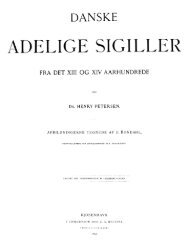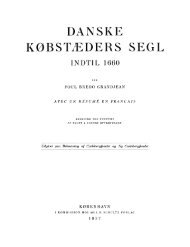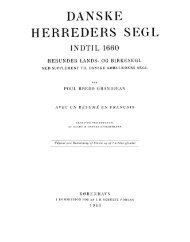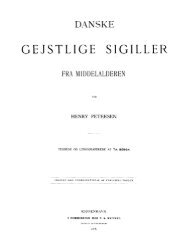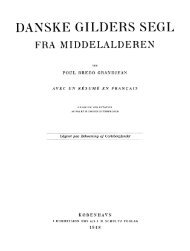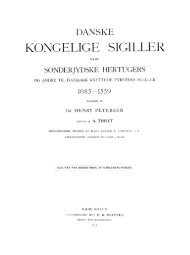Oldtidsagre - Genstandskundskab
Oldtidsagre - Genstandskundskab
Oldtidsagre - Genstandskundskab
You also want an ePaper? Increase the reach of your titles
YUMPU automatically turns print PDFs into web optimized ePapers that Google loves.
172 Nr.l<br />
\Vith regard to the Danish “()ldtidsagre", it is of especial interest that the fieldsystem<br />
of the old individualistic organization in Cotentin, in Bretagne, and in the<br />
Central Plateau (cf. BLOCH 1931, Pl. X-XII) has a striking resemblance to the ancient<br />
fields of Jutland. In the Central Plateau, above the present line of cultivation,<br />
one may see numerous deserted fields from several periods, very similar to the Jutland<br />
ancient fields of the broad type. The geoprapher L. AUFHERE and the archaeologist<br />
PIERRE FOURNIER, Clermont Ferrand, have kindly pointed out to me these<br />
deserted fields in the Central Plateau, in the summer 1938.<br />
The broad, irregular fields in France are apparently bound up with the araire.<br />
In the Mediterranean region, ploughs of the arð-type are still in use, and the broad,<br />
irregular fields have also survived.<br />
Outside Europe. If we investigate the ploughs and the field-types outside our<br />
part of the world, we shall find the connection between the arð and the broad, irregular<br />
fields also in South and East Asia. This holds good e. g. of the rice-fields<br />
of Asia, whose field-systems may have a striking similarity to groups of ancient fields<br />
in Jutland.<br />
The relation between the arð and the broad field may be regarded as a result<br />
of the ploughing in two directions. Analogically, the strip-fields may be regarded as<br />
a result of ploughing with a heavy mould-board plough. It seems justifiable to look<br />
upon the broad field as an older form than thestrip-field, just as the arð is older than<br />
the mould-board plough. However, one should not disregard the fact that broad fields<br />
may be formed without any arð, and narrow fields without any mould-board plough.<br />
The Norwegian “reitar“ are cultivated with spade, and the very similar plot-fields<br />
from Early Bronze Age or Late Stone Age, which CURWEN has found in Dartmoor,<br />
may have been cultivated with a digging-stick. The narrow fields or beds, which<br />
VAN GIFFEN discovered beneath grave-mounds at Zeyen, seem to have been cultivated<br />
with a hoe.<br />
A study of the field-system of ancient Mexico, where the plough was unknown,<br />
may also act as a warning against an unreserved belief in a theory about fieId-sytems<br />
resulting from types of agricultural implements. The Nahuas had reached a<br />
field-system, reminding of that which, in Europe, is connected with the wheel-plough<br />
(ScHMu5;D15R 1930, p. 27, Fig. 23, pp. 28-29, Plan 2. SCHILLING 1939, pp. 34 seqq.).<br />
It is probable, however, that not only strip-fields, but also broad fields of a more<br />
irregular outline were used in ancient Mexico. At least, such irregular fields are cultivated<br />
to-day by the Zapotec Indians (SCHMIEDER 1930, p. 15 and PI. 30b).<br />
VIII. Conclusion.<br />
Our assertion, that the ancient fields of Jutland and probably also the Dutch<br />
and the English fields of the same type were tilled with an arð, does not rest upon<br />
any theory about the arð producing of necessity broad fields, or broad fields im



